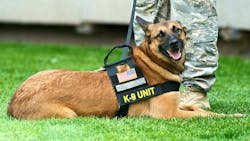With the increase of body-worn, in-squad and casual observer videos of traffic stops these days, more and more K-9 vehicle sniffs are recorded. The result has been more and more attorneys, judges, and juries are able to see a dog’s alert on a vehicle. The indication by a dog’s nose has been legally compared to an officer’s eyes when determining probable cause to enter and search a vehicle absent search incident to a lawful arrest. However, the reliability of a dog’s nose must be proven through documentation of training and experience. Which leads me to search patterns.
As a former K-9 handler, I recall my trainer’s meticulous requirement of making sure the dog sniffed around the whole exterior of a car. The dogs started on one corner of the car, worked their way around clockwise to the starting point, and then doubling back in the opposite direction to give the dog two passes in each direction. All the while, we as handlers watched for pauses, head tilts, sniffing changes, and general excitement. Even when the dog showed interest, we were trained to keep the dog moving and come back to the area where the dog peaked its attentiveness.
Yet as more K-9 sniffs are visible to the world via video captures, I am seeing more handlers not searching the entire vehicle in a trained pattern. More often than not, the handler takes the dog directly to the passenger’s side door and has the dog sniff the door seal area. If the dog alerts, out pops the reward and the dog is put back up in the squad. This isn’t a thorough search, and leaves openings for challenges in court as to the reliability of the alert.
The purpose of methodical and complete searching was done for several reasons. First and foremost, dogs are dogs. They are interested in all sorts of odors that may include other animals, food, trash, and anything the dog is curious about. A dog that pauses on a door hinge or trunk may be smelling several ounces of heroin or a fast food container from two weeks ago. By keeping the dog moving, you are not only forcing the dog to stay focused on the mission, but you are also watching and noting the dog’s reaction to the entire car.
Second, a methodical search of the entire vehicle can also help find drugs that are hidden in various locations on a vehicle. This is especially critical when doing interdiction projects or if a dog is sniffing a suspected trafficker’s vehicle. Third, a methodical and complete search twice around the car keeps the dog’s attention and focus on the “game” of finding drugs. The art of training a dog to locate drugs is making it a game for the dog, with a reward and handler praise if they “find” the drugs and alert. If the dog comes out and only is able to sniff a small portion of the vehicle, that game will get boring fast, which leads me to the final reason for thorough sniffs….reducing false alerts.
Doing a complete and methodical search will help eliminate false alerts by handler observations and control of the dog. A dog who is only allowed to sniff a door will soon learn that an alert on a door means reward. However, a dog involved in a complete and thorough search will know that only when a scent is identified and alerted to a reward be given. By expanding the sniff to the entire vehicle with rotations clockwise and counter-clockwise will allow both dog and handler to assess the entire situation and demonstrate that an alert was done on a specific area(s) of a vehicle after a complete search. The thoroughness of this pattern is also hard to argue in court.
The sniff of an entire vehicle will also help during times when nothing is found in the vehicle after a dog’s alert. The dog cannot tell you the difference between residual drug odor and present drug odor. Every handler has experienced times when their dog alerted on a car and nothing was found. Possibly, the driver or occupant may admit to possession or use prior to the stop, to which the handler should record this as a positive alert and comment on such in their record database. However, lacking any admission or evidence, the dog must be recorded with an unfounded or false positive alert. Too many of those on your training and deployment records, and attorneys and juries take notice.
The old saying goes, “do on the street as you do in training.” I would be hard-pressed to find a reliable K-9 trainer or certification body that would not want you to thoroughly search a vehicle, building, or article for the reasons I stated. If you are cutting corners on the street, you are opening yourself up for claims of incompetence and unreliability and only setting your dog up for failure. By searching the car thoroughly and properly, you will increase your overall success and track record with your furry partner and lead to higher reliability rates.
About the Author
Brian Landers
Brian Landers is a former law enforcement officer and current professor of criminal justice. He also serves as an expert consultant and witness for police use of force incidents throughout the United States. He can be reached at [email protected]

